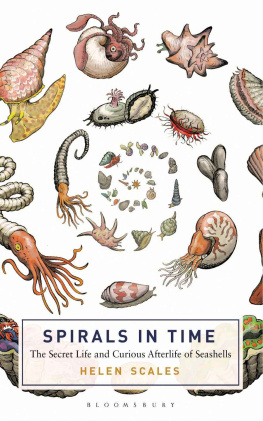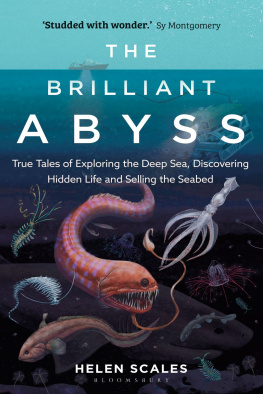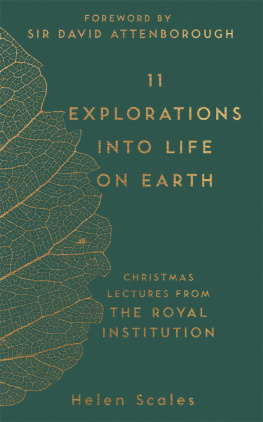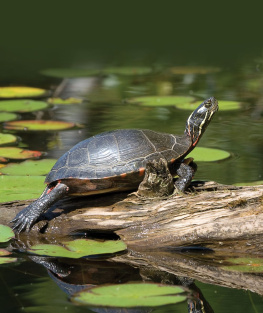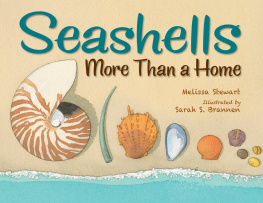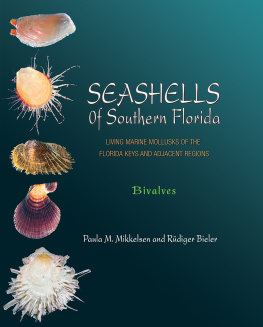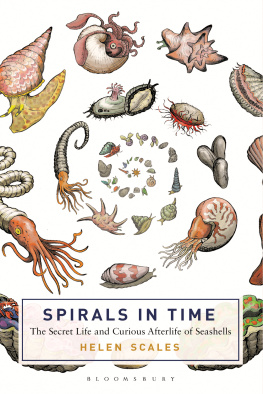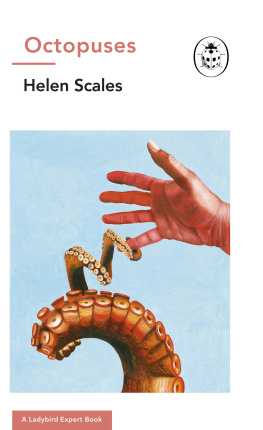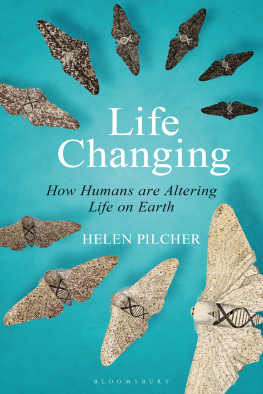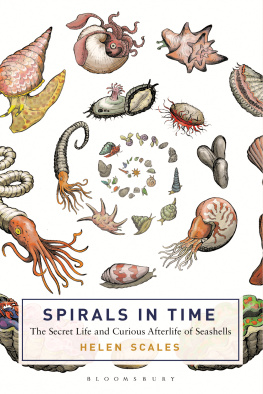SPIRALS IN TIME
Also available in the Bloomsbury Sigma series:
Sex on Earth by Jules Howard
p : The Gene that Cracked the Cancer Code by Sue Armstrong
Atoms under the Floorboards by Chris Woodford
SPIRALS IN TIME
The Secret Life and Curious Afterlife of Seashells
Helen Scales

For Katie and Ruth
Contents
N ever go anywhere without your seashell. At least that was the rule that Triton lived by. He was a merman top half human, bottom half fish and a demigod in Greek mythology, not a fully fledged deity. Nevertheless, he did his best to dash around playing his trumpet, which was fashioned from a large shell with the end cut off; he used the trumpets ear-splitting roar to scare off raging giants and command the seas. Triton was often outshone by his famous parents Poseidon and Amphitrite, the god and goddess of the sea, not to mention his extended family. Poseidon fathered a prodigious and eclectic assortment of offspring: there was a man-eating cyclops, a sea monster that stirred up island-swallowing whirlpools, a talking stallion, and a sea-nymph who could control violent waves and married a giant with a thousand hands and fifty heads.
Then there was Triton with his shell. His special power was perhaps not as flashy as those of some of his siblings and in-laws, but he was still someone not to mess with. One story tells of Misenus, a mortal from the city of Troy, who thought himself a gifted trumpeter and rashly challenged Triton to a musical contest. Outraged by all the boasting, the demigod shoved Misenus in the sea and drowned him. It seems Triton was a bit sensitive about his seashell trumpet.
Beyond myths and stories, seashells have always been highly valued and revered in the real, human world. Since prehistoric times, we have found shells, picked them up and looked at them in wonder. People have contemplated the seashells beautiful shapes and the mysterious ocean realm they come from, and turned them into great treasures. For centuries, the wail of conch trumpets has echoed across the peaks of the Himalayas, calling Tibetan Buddhist monks to prayer. The conch shells inhabit the Indian Ocean and have been carried hundreds of miles inland, high into the mountains, where they are carved with intricate designs, decorated with jewels and precious metals and adorned with colourful ribbons. Standing on the rooftops of monasteries, monks play shell music into the skies to ward off approaching storms and drive away evil spirits.
Sadly, though, in more recent times, people have begun to lose this sense of awe in seashells. Their magnificence is fading and being replaced instead by inelegant clutter. I brooded on this while hunting around the internet for the words seashell and figurine. A cavalcade of aquatic kitsch unfolded across my screen, and one image in particular stuck in my mind: a little seashell man. His body was a large cowrie shell, his head a slightly smaller one the opening gave him a goofy, crinkled smile and glued on top was a cockleshell hat. His arms and legs were made from four twisted turret shells that poked out at odd angles, and he sat on an elephant made from a dead starfish with one leg raised as a trunk and clam shells for ears (not to worry, though Im sure its what the starfish would have wanted). Another spectacle of shellcraft dreck available to buy at optimistically high prices was a series of ceramic human heads covered in dreadful jumbles of seashells along with strings of pearls, craggy antlers of dead coral and glittering rhinestone seahorses; these unfortunate mannequins looked like mermaids whod fallen into Poseidons treasure chest and come out much the worse for wear.
I encountered yet more seashell trinkets in a rather unexpected place. At Londons Natural History Museum I was invited to go behind the scenes to the basement rooms, where their phenomenal shell collection is kept. They have millions of specimens, catalogued and neatly arranged species by species, but as I walked in the first thing I saw was a glass-fronted cupboard housing a miscellany of altogether more peculiar objects. The curators call this their cabinet of horrors. It contains the various shell paraphernalia theyve been given over the years; some are real shells, others are plastic replicas. Among the gubbins there are ornamental ships with sails made from scallops, and a telephone shaped like a conch shell, taking the phrase a word in your shell-like to its logical conclusion after the Victorians noted that human ears have a spiralling shape similar to shells. Theres a tiny shell-covered piano, and a stack of cowrie shells, each with plastic eyes and a pair of wire-rimmed spectacles that transforms them into studious turtles. Gluing a pair of wobbly eyes on a cowrie is harmless enough, I suppose, but its a far cry from the men and women who buried their dead with shells in a sign of great respect and mourning. Im not saying we should go back to placing shells in graves, but youve got to admit that its funny how things change.
Even when theyre not being sculpted into truly horrible ornaments, seashells have gained something of a reputation as clichd emblems of the beach and disposable tokens of all things nautical. Lots of us live in cities permanently tuned into the digital world and out of the natural world so its perhaps no surprise that when shoppers buy flip-flops studded with cowries, or shell necklaces, or lampshades made from Windowpane Oyster shells, most will have no idea where these things came from, or realise that they were made by living, wild animals.
Despite all this, there is still something about seashells that even in our busy modern lives makes many of us stop and wonder for a moment. We find them on beaches, we enjoy the feel of them in our hands, and we hold them to our ears to see if the stories are true about the sound of waves getting trapped inside. Then we take them home and arrange them on bookshelves or in the bathroom, where they remind us of a tranquil day at the coast and equip us with delicate connections to the sea. As well as being something elegant to look at, and a small treasure we found for ourselves, the shells whisper tempting questions. Where do all the shells come from? Who or what sculpts them? How are they made and, perhaps more intriguingly, why?
This book will answer those questions, and many more besides. It is my attempt to set the record straight, to throw out the novelty knick-knacks and reinstate seashells to their rightful place as glorious objects that can tell us so many things. I will show how seashells can offer us insights into the minds of our distant ancestors, and teach us about beauty and form and the curiosities of life on Earth. I will tell the stories of some of the people who have devoted themselves to shells; people who have used them in ways that make the afterlife of seashells both surprising and splendid. And I will put the animals back inside their shells and reveal the extraordinary lives of the shell-makers.
Take the seashells known as Giant Tritons, named after the Greek demigod and often used to make trumpets in the real world. Now and then they can be spotted swaggering around on coral reefs in the Indian and Pacific Oceans, their huge shells in tow; with handsome, elongated twists like polished tortoiseshell and bigger than an actual trumpet, these are one of the largest and finest of all the seashells. From under a tritons shell protrudes a single, muscly foot covered in leopard spots, a pair of yellow and black striped tentacles, and a pair of piggy eyes. Their highly sensitive tentacles probe and taste the water for the whiff of dangerous animals that plenty of other reef denizens hope never to bump into.
Next page
